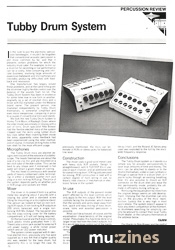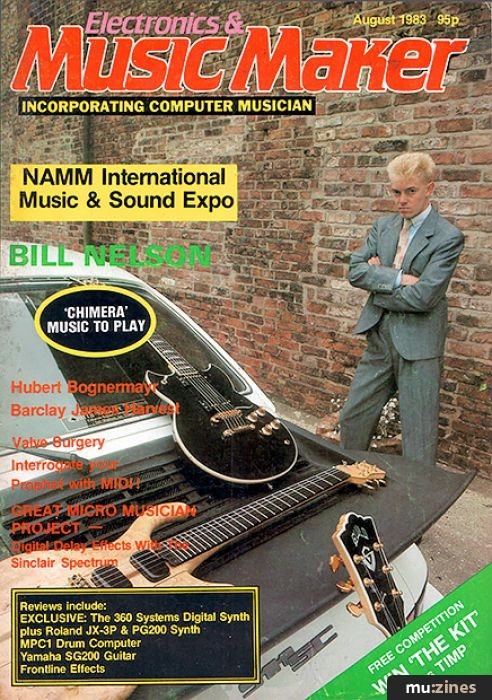Magazine Archive
Home -> Magazines -> Issues -> Articles in this issue -> View
Tubby Drum System | |
Article from Electronics & Music Maker, August 1983 | |

In the rush to join the electronic percussion bandwagon, it mustn't be forgotten that conventional acoustic percussion is still more common by far, and that it presents certain problems for which the industry must cater. For example, to mic up a drum kit for recording or live performance can be a costly, time-consuming and intricate business, involving large amounts of expensive metalwork and microphones and inevitably producing difficulties with feedback and resonance.
One manufacturer has largely solved these problems, and at the same time given the drummer highly flexible control over the balance of the sounds from his kit. The Tubby Drum System has been in existence for some time now in one form or another, originally as a set of electret mics and a mixer with EQ marketed under the Melanie brand name. The present version, now marketed independently by Tubby Drum themselves, is somewhat simplified and even more inexpensive, comparing in price to a couple of conventional mics and stands.
We took the new Tubby Drum System to Honky-Tonk Music of Rayleigh, Essex, where the older model was already on display with a pair of toms. Drum specialist Pete Brewer had the flexible electret mics of the system clipped over the skins using rubber drum key clips rather than inserting them inside the toms; apparently some feedback had been experienced using the latter method, and of course, it involves drilling holes in the tom shell for the most efficient usage.
Microphones
The Tubby Drum mics are electret designs reminiscent of the earpiece of a stethoscope. The heads themselves are about the size of a tie-clip mic and are mounted on a ten-inch tube of flexible rubber. This can be bent to any shape and if immersed in hot water will retain a given shape on cooling.
The mic head is continuous with several yards of heavily rubberised cable, terminating in either a standard quarter inch jack plug or a non-locking XLR plug. The price of the system depends partly on whether jack or XLR plugs and sockets are fitted.
Mixer
The mixer in its present form is a yellow metal box weighing about 3 pounds with a sloping top panel and a standard screw fitting for mounting on a microphone stand. The version we looked at had six non-locking XLR inputs, 6 non-locking XLR outputs at 200 ohms balanced, and a single non-locking XLR Mix Output. The top panel also has the snap-locking cover for the battery compartment, a 9 volt cell being required.
On the back panel are the 6 level controls, black plastic knobs graduated from 1-10. There's also a mini-jack socket for external 9 volt power supply, a white rocker power switch and an LED power indicator.
The system comes supplied with 6 identical electret mics; previously only five were supplied as it was felt that a higher quality mic was needed for the bass drum, but apparently this is no longer the case. As previously mentioned, the mics can terminate in XLRs or stereo lacks for balanced line level.
Construction
The mixer uses a good solid metal case with heavy duty XLR sockets. Design is straightforward, with 6 TL072CP ICs in use, one on each channel, and an additional one for overall mixing level. 47K log pots are used for mixing. PCB construction is neat with a certain degree of hard wiring in use, so there's little chance of mechanical or electronic failure in the system.
In use
The XLR outputs of the present model aren't affected by the level controls which only apply to the mix output. With the level controls facing the drummer, which means that the sockets and jacks slope away from him, quick and easy mixing of bass drum, snare, toms and assorted percussion is possible.
What can't be achieved, of course, are the equalisation characteristics of the original model. Presumably this has to be done on a larger mixer fed from the direct outputs, but this would take tone control out ot the hands of the drummer again, which would tend to remove half the point of the system.
The microphones themselves behave admirably however. They're highly directional, virtually immune to distortion and fast to respond. Sharp roto-tom sounds reproduce well, with every aspect of attack and decay intact, and the Roland JC Series amp used was exploited to the full by the mics' wide frequency response.
Conclusions
The Tubby Drum system as it stands is a simple way for acoustic percussionists to save large amounts of time and money. The mics can be attached to stands or to the drums themselves, under or over cymbals or through a special hole in a drum shell, or if you're lucky through an existing breathing hole. It's also possible to mount an XLR connector on the drum shell and leave the mic permanently inside, probably the ultimate in efficiency during setting up.
Removing the equalisation facilities from the original design seems an odd development, implying that the drummer can only rely on the accuracy of the mics' reproduction. Luckily this is very high in most applications. The system doesn't appear to have any direct competition at the moment, so drummers searching for simplicity can only be advised to contact their local Tubby Drum dealer, or the company themselves at the address below.
Our thanks to Pete Brewer and the staff of Honky-Tonk Music for their help in this review. The Tubby Drum 6-mic system costs between £250 and £300 depending on whether jack or XLR sockets are specified. Latest prices from Tubby Drum, (Contact Details).
Also featuring gear in this article
Publisher: Electronics & Music Maker - Music Maker Publications (UK), Future Publishing.
The current copyright owner/s of this content may differ from the originally published copyright notice.
More details on copyright ownership...
Gear in this article:
Review
Previous article in this issue:
Next article in this issue:
Help Support The Things You Love
mu:zines is the result of thousands of hours of effort, and will require many thousands more going forward to reach our goals of getting all this content online.
If you value this resource, you can support this project - it really helps!
Donations for April 2024
Issues donated this month: 0
New issues that have been donated or scanned for us this month.
Funds donated this month: £7.00
All donations and support are gratefully appreciated - thank you.
Magazines Needed - Can You Help?
Do you have any of these magazine issues?
If so, and you can donate, lend or scan them to help complete our archive, please get in touch via the Contribute page - thanks!





